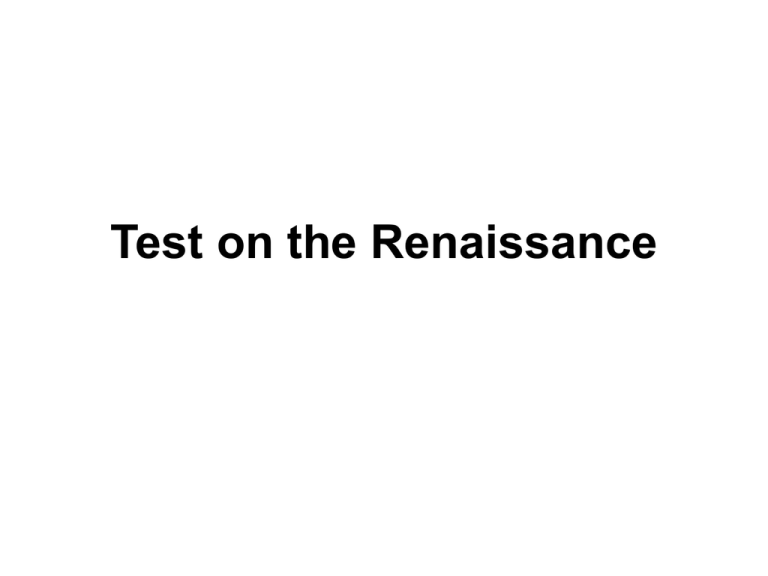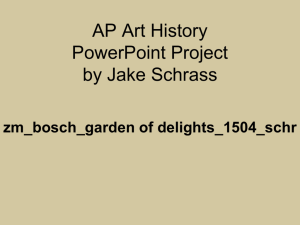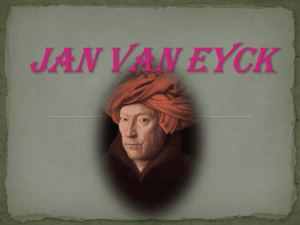Test on the Renaissance
advertisement

Test on the Renaissance Scholasticism & Humanism • Scholasticism: a church-based intellectual system in which reason was applied to explain all aspects of life, but most importantly, to why Christianity was the only logical belief system (1200s-1300s) • Humanism: a more secular system seeking to apply reason to all aspects of life, not just religion; an attempt to apply ancient Roman principles, filtred through Christianity and a Christian World view, to contemporary life (1390s-1600) 19-9 Giotto, Lamentation over the Dead Christ • Scene from Life of Christ; immediately after Crucifixion • Not biblical • Shallow stage/landscape for figures • Emotionalism in response of apostles, angels 19-10 Giotto, Meeting of Joachim and Anna • Fresco from life of Mary’s parents: Joachim & Anna • Not Biblical • Note different scale for architecture & figures • Use of light & shade to model figures 19-21 Ambrogio Lorezetti, Allegory of Good Government The 15th Century Outside of Italy • 1348-1400: General instability due to aftermath of plague, continuing outbreaks. • 1337-1453: Hundred Years’ War between England and France. • Flanders, chief market for England’s wool, became a major battle ground. • French incursions into Flanders aggravated this prolonged conflict. Cloth: More Precious than Gold • Textiles: among the most valuable European commodities up to the 19th century. • Process: labour intensive hand work, elaborate designs, rich materials. • Value of cloth often surpassed that of jewelry, books, artwork. • Fully equipped bed: mattress, hangings, sheets, blankets, pillows, etc. could equal half the value of a cottage in England c. 1525. Of Capitalism and Kings • Kings consolidated power over large territories, established common currencies, legal systems, bureaucracies. New national monarchies (nation states) emerge. • Barter system replaced by cash economies. • Money financed new industrial (e.g. textiles) ventures as well as the art market. • Emerging urban middle classes, with large incomes, changed the market for art in northern Europe. 20-1 Limbourg Brothers, Très Riches Heures du Duc de Berry 20-11 Robert Campin, Mérode Altarpiece • Oil on wood, 64 x 118 cm, Metropolitan Museum of Art, New York 20-11 Robert Campin, Mérode Altarpiece 20-11 Robert Campin, Mérode Altarpiece • The centre panel focuses on the Virgin in prayer. As she has not yet recognized the presence of the archangel Gabriel, the event depicted is the moment just before the Annunciation. Some objects, such as the lily and the laver, symbolize the Virgin's purity expressed through the divine birth of Christ. The tiny figure of the Christ Child bearing a cross and descending on rays of light from the round window indicates that the primary subject is the Incarnation. This understanding is borne out by the flame of the candle, symbolic of God's divinity, which has just been extinguished, a further reference to the Incarnation, the moment when God became man. This significant detail is placed in the exact centre of the composition. 20-11 Mérode Altarpiece • The presence on the right panel of Joseph, who is not usually attendant at the Annunciation, can also be explained in the context of the Incarnation. Joseph has made two mousetraps, whose meaning is elucidated by the Augustinian speculation that the Incarnation was God's means of ensnaring the devil, much as bait entraps a mouse. 20-12 Jan Van Eyck, Arnolfini “Wedding” Portrait • National Gallery, London: Oil on oak, 82.2 x 60 cm, 1434. • This work is a portrait of Giovanni di Nicolao Arnolfini and his wife, Giovanna Cenami, but is likely not intended as a record of their wedding. Arnolfini was a member of a merchant banking family from Lucca living in Bruges. • His wife is not pregnant, as is often thought, but holds up her full-skirted dress in the contemporary fashion. • The couple are shown in a wellappointed interior, a scene rich in symbols of marriage and family life. Arnolfini “Wedding” Portrait (symbols) • • • • Van Eyck surrounds the couple with many symbols. To the left, the oranges placed on the low table and the window sill are a reminder of original innocence, of an age before sin. Unless, that is, they are not in fact oranges but apples, in which case they would represent the temptation of knowledge and the Fall. Above the couple's heads, the candle left burning in broad daylight on one of the branches of an ornate copper chandelier can be interpreted as the nuptial flame, or as the eye of God. The small dog in the foreground is an emblem of fidelity and love. The marriage bed with its bright red curtains evokes the physical act of love which, according to Christian doctrine, is an essential part of the perfect union of man and wife. Arnolfini “Wedding” Portrait (mirror) • • The mirror is the focal point of the whole composition. It has often been noted that two tiny figures can be seen reflected in it, their image captured as they cross the threshold of the room. They are the painter himself and a young man (van Eyck’s brother Hubert?), perhaps arriving to act as witnesses to the marriage. The essential point, however, is the fact that the convex mirror is able to absorb and reflect in a single image both the floor and the ceiling of the room, as well as the sky and the garden outside, both of which are otherwise barely visible through the side window. The mirror thus acts as a sort of hole in the texture of space. It sucks the entire visual world into itself, transforming it into a representation. 20-15 Jan Van Eyck, Man in a Red Turban • Secular Portrait; possibly a self-portrait (artists would sometimes wrap their hair to keep paint off) • Direct gaze of sitter - new since antiquity • May reflect the increasing patronage of portraiture by the growing middle class. • Avoid psychological reading! His “gaze” may merely be into mirror! 20-17 “The Garden of Earthly Delights” • The “Millennium” altarpiece, closed, by Hieronymous Bosch, c. 1500 (in the Prado). • Exterior of Bosch’s altarpiece containing the “ Garden of Earthly Delights” • The front depicts the separation of the earth from the waters during Creation. The Garden of Earthly Delights • Hieronymous Bosch produced some of the most inventive fantasy paintings that have ever existed. His obsessive and nightmarish vision has its antecedents in the Gothic twilight world of the late Middle Ages and, although the allegorical medieval world view is now lost, there have been many recent attempts to 'read' his pictures, not least by those who have attempted to interpret Bosch by dream analysis. The Garden of Earthly Delights demonstrates Bosch's dazzling ability to build up a hugely detailed landscape through a series of bizarre exaggerations and distortions. The complete work consists of four paintings on a series of folding panels; the outer panel reveals the Third Day of Creation when closed. Inside, The Garden of Earthly Delights is flanked on the left by the Garden of Eden and on the right by Hell. A wild sexual orgy features in the central panel, where lust is shown to be the cause of man's downfall. There are over a thousand figures in this work altogether. Standing alone in its lifetime, Bosch's work has a timeless and modern quality that greatly endeared him to Surrealists in the twentieth century.”The A-Z of Art: The World's Greatest and Most Popular Artists and Their Works,Nicola Hodge and Libby Anson 21: 17 The Garden of Earthly Delights Martin Schongauer, St. Anthony Tormented by Demons • Engraving, 1480-1490 • Produced using a metal printing “plate” etched by metal stylus • Note the very fine lines, softer detail, more curved lines than in the woodblock. • St. Anthony’s vision of a soul tormented by demonic creatures. Bottacelli: Birth of Venus Leonardo da Vinci Last Supper Leonardo da Vinci, Embryo Leonardo da Vinci, Virgin of the Rocks Bramante: Tempietto Bramante: Plan for St. Peter’s Michelangelo: Creation Michelangelo: David Donatello: David Michelangelo: Last Judgement Raphael: The School of Athens Michelangelo: St. Peter’s Giorgione: The Tempest Titian: Venus of Urbino Titian: The Assumption of the Virgin Parmigianino: Madonna of the Long Neck Veronese: Feast in the House of Levi The Isenheim Altarpiece Albrecht Durer: Knight, Death & the Devil Hans Holbein, The French Ambassadors Breugel, Hunters in the Snow




